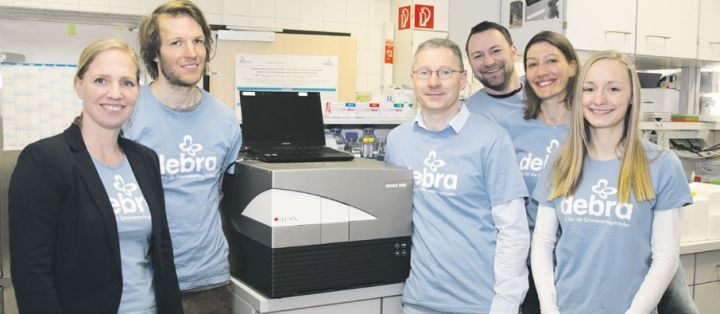Keywords:
Small molecule drug discovery involves a range of functional assays that have traditionally relied on manual cell counting techniques to monitor proliferation, migration and invasion. Automated cell counting is enabling the EB House Austria to save time and free up personnel, as well as designing time-course experiments that were previously unachievable.
The EB House Austria is a unique, highly specialized clinic for patients with epidermolysis bullosa (EB), a rare inherited disease that causes the skin to become ‘as fragile as a butterfly’s wings’, blistering in response to friction or trauma. The clinic, located within the University Hospital of Salzburg, was the initiative of patient organization DEBRA Austria, and opened in 2005. The EB House consists of three units: the EB outpatient clinic; the EB academy; and a research arm developing therapies to treat the disease. The clinic’s 30-strong group of researchers is divided across three areas: gene therapy; basic research into cancer and wound healing; and small molecule development and epigenetics. Dr Verena Wally, Group Leader of Small Molecules Research, explained: “The main aim of my group is to identify potential therapeutic targets, while the gene therapy team is hoping to tackle the problem at its root, by replacing or correcting genes using different technologies, such as CRISPR, conventional DNA therapy or trans-splicing.”
“Our research covers the full spectrum of the disease, from the milder EB simplex (EBS) to the most severe form – recessive dystrophic epidermolysis bullosa (RDEB) – which ultimately leads to premature death from chronic wounds that develop into cancers. Our initial focus was on EBS, where we discovered an inflammatory pathway that is constitutively activated in the patient population. We repurposed the interleukin-1 beta inhibitor diacerein – which is used in the treatment of osteoarthritis – to treat these patients. This project has since been out-licensed to a pharma company, and has now entered phase III clinical trials. Our attention then turned towards treating RDEB, where we are currently studying differently regulated microRNAs in developing tumors to identify potential biomarkers.”
“A large variety of functional assays were needed to support our research, and we purchased a Spark® multimode microplate reader back in 2016 to meet the workload. We carry out confluence measurements for many proliferation, migration and invasion assays, as well as using luminescence to study the interactions of microRNAs with three prime untranslated regions (3’-UTRs), and to assess cell viability with tetrazolium dye MTT assays. We also investigate transfection efficiencies, for example by looking for green fluorescent protein expression.”

Members of the EB House research team (left to right): Verena Wally, Michael Ablinger, Thomas Lettner, Roland Zauner, Monika Wimmer and Melanie Böhm
“In September 2017, we purchased the Gas Control Module (GCM™) and Live Viewer, which offered us the expanded functionality we need. The reader has brought huge benefits to our workflow. Previously, we were carrying out migration assays by hand; taking pictures with a microscope and using cell counting software or counting them ourselves. For luminescence assays, we were fortunate to be able to use systems from other departments, but it was time consuming to move between locations, particularly when running time-course experiments. Reproducibility has been a key advantage of the new platform, as the reader removes any user bias or human error, and we can now measure even smaller cell sizes, expanding the range of cell types we can analyze. In addition, the Spark can handle higher density plates, enabling us to measure a greater number of samples in a single run. We can also now carry out largescale migration assays involving 12 plates, something we couldn’t do previously. Ultimately, the greatest benefits have been the time saved and the personnel it frees up. The platform now runs every day, and is used by all the groups.”
"Reproducibility has been a key advantage of the new platform, as the reader removes any user bias or human error, and we can now measure even smaller cell sizes."
“We are currently preparing to run time-course experiments over 24 hours, measuring every two hours to monitor the proliferation and viability among other factors. Before the Spark, we were limited to taking measurements of time points when we were actually in the lab – say after eight hours, 12 hours and 24 hours – but this could lead to us missing the time point that would actually be important. Leaving the plate in the reader and taking readings every two hours will be hugely beneficial. Gone are the days when if we missed the event, we had to start again from the beginning.”
“We chose to purchase the Spark on the back of a conversation with another lab, and Tecan’s reputation for excellent customer service. We have been impressed by the responsiveness and level of technical support that we have received. We’re fortunate to be only 20 kilometers from the Tecan office and, if we have a problem, a Tecan team member gives us a call or visits the site; it was a deciding factor in choosing to upgrade the system,” Verena concluded.
To learn more about the EB House Austria, go to www.eb-haus.org/en/home.html
Keywords:









